8 Cavity Myths Parents Still Believe (And Why They’re Holding Your Kid Back)
Let’s talk about cavity chaos.
You know that heart-dropping moment when you spot a tiny brown dot on your child’s tooth and instantly spiral into a 2 a.m. Google search about “kids cavities”? You’re definitely not alone; every parent has been there, wondering if it’s sugar, genetics, or that one night your little one skipped brushing.
But here’s the truth: a lot of what we think we know about children’s dental health is based on myths that have been passed down from playground gossip, well-meaning grandparents, and outdated “mom blogs.” These myths sound harmless, but believing them can actually delay proper care, increase anxiety, and even make small dental issues turn into big, expensive ones later.
The numbers don’t lie: according to the CDC, nearly 1 in 5 kids under age 5 has untreated cavities. That’s not just about toothaches; it affects eating, sleeping, and even learning.
So before you panic or blame the cookie stash, let’s separate fact from fiction. Grab your coffee (or your kid’s favorite sippy cup), and let’s bust 8 common cavity myths that might be quietly holding your child back from their brightest, healthiest smile.
1. Do Baby Teeth Really Need Cavity Treatment Since They Fall Out Anyway?
Absolutely. And this is the #1 myth that makes pediatric dentists cringe.
Those tiny teeth aren’t just for cute smiles or chewing Cheerios; they’re the architects of your child’s future smile. Each baby tooth holds space for the permanent one growing underneath. When a cavity is left untreated and a baby tooth falls out too soon, the surrounding teeth start to shift, crowding the space where the adult tooth is supposed to emerge. The result? Misalignment, crooked teeth, and often, braces down the road.
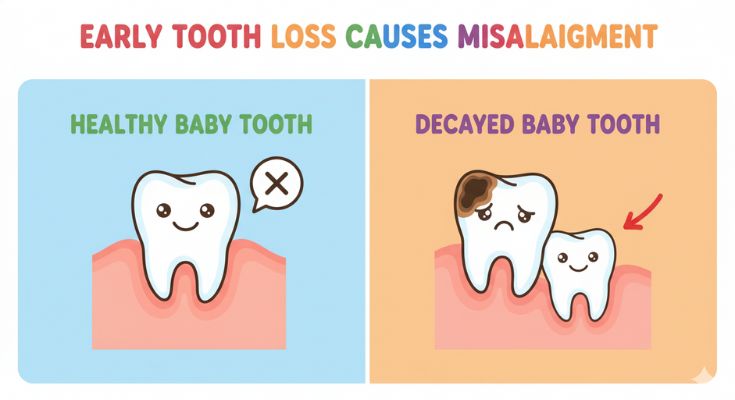
But it’s not just about looks. Cavities in baby teeth can cause serious pain, infections, and even interfere with your child’s speech and eating habits. In short, ignoring baby tooth decay doesn’t save time or money; it can actually make things a lot more complicated later.
Learn more about the real causes and treatments for kids’ cavities to understand how early care can make a lasting difference.
2. Are Cavities in Kids Just Normal and Unavoidable?
“Every kid gets cavities; it’s just part of childhood.”
Hard pass.
Yes, cavities are common, about 42% of kids aged 2–11 have them in their baby teeth, but that doesn’t make them normal. Cavities aren’t a rite of passage; they’re a preventable disease.
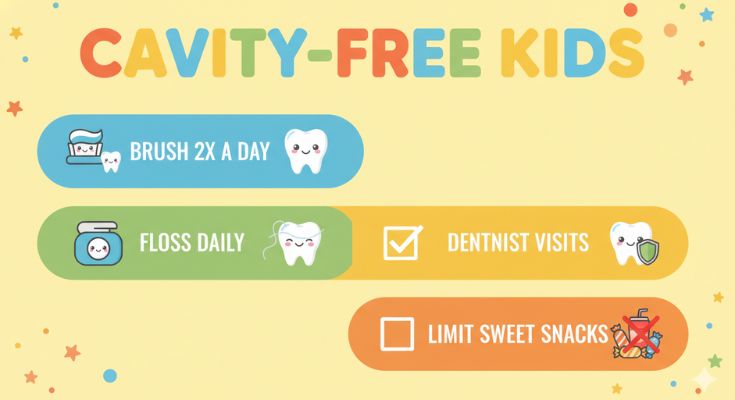
Here’s the good news: you have 95% control over cavity prevention. It’s not about perfection; it’s about small, consistent habits that make a big difference.
Brush twice a day with fluoride toothpaste
🍎 Limit snacking (even those “healthy” crackers and gummies count!)
🦷 Schedule the first dentist visit by age 1
💡 Also, check out our guide on hidden sugar in kids’ food, you’ll be surprised which “healthy” snacks secretly feed cavity-causing bacteria.
Think of it like this: cavities don’t “just happen”; they sneak in when routine care slips. And teaching these simple habits early not only saves you from future dental drama but also helps your child build lifelong confidence in their smile.
3. Will a Cavity Just Disappear When the Baby Tooth Falls Out?
If only, right?
Wishful thinking, friend.
A cavity isn’t just a hole in a tooth; it’s a red flag that cavity-causing bacteria are thriving in your child’s mouth. So even if that baby tooth eventually wiggles out, the bacteria don’t pack up and leave. They hang around, ready to attack the new permanent teeth the moment they appear.
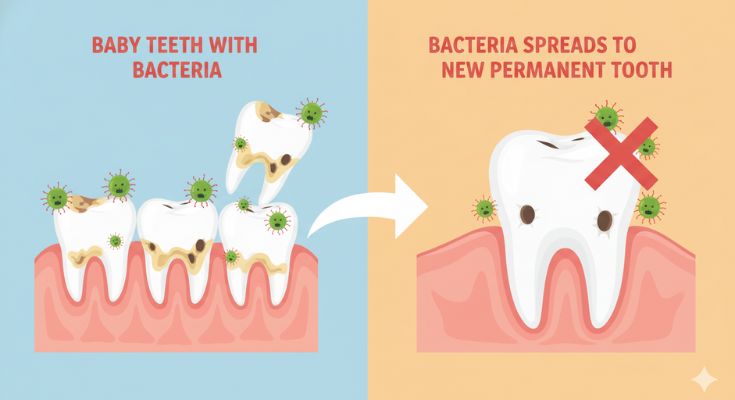
Here’s the not-so-fun fact: Kids with untreated cavities in their baby teeth are 3× more likely to develop decay in their adult teeth.
Treating cavities early doesn’t just save one tooth; it helps protect your child’s whole future smile.
4. Can Brushing and Flossing Actually Heal a Cavity?
We love a solid brushing and flossing routine; it’s the foundation of every healthy smile. But here’s the truth: once a cavity forms, no amount of brushing can “heal” it.
When tooth enamel is gone, it’s gone. Brushing and flossing can definitely slow down the damage and stop new cavities from forming, but they can’t rebuild what’s already been lost. Only a dentist can repair that tiny hole with a filling or sealant to keep bacteria from digging deeper.
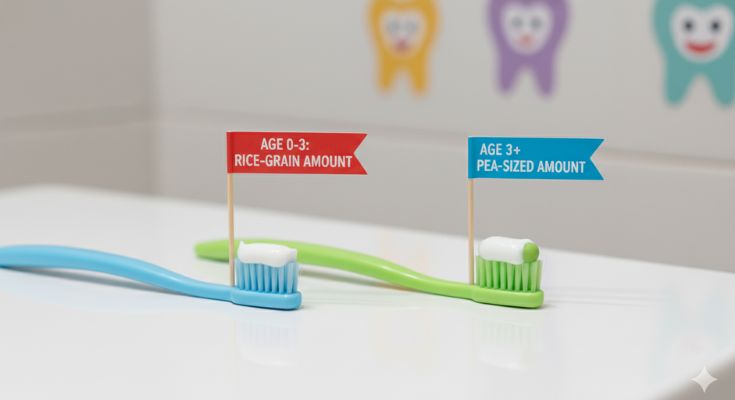
Think of brushing as maintenance, not repair. It’s like washing your car; it keeps things clean, but it won’t fix a dent.
Want to make sure your child’s brushing technique is effective? Here’s a quick guide on proper brushing techniques recommended by dental experts.
5. Is Sugar the Only Thing That Causes Cavities?
We get it, candy’s the usual suspect.
But here’s the plot twist: sugar isn’t the only villain in this story.
Crackers, chips, bread, and even those “healthy” fruit snacks can be just as sneaky. These starches break down into sugars that feed cavity-causing bacteria. The real troublemaker isn’t just what your kid eats, it’s how often they eat.
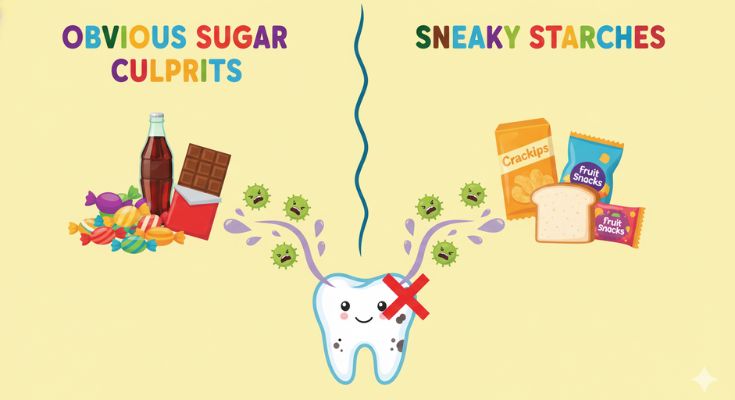
Every snack triggers a mini acid attack in the mouth. So when kids nibble all day without brushing or rinsing, their teeth basically take an acid bath that wears away enamel bit by bit.
Build a cavity-safe daily routine with this simple morning routine for healthy gums to start each day right.
6. Are Cavities Mostly Genetic, Like “Soft Teeth” Run in the Family?
We’ve all heard it, “Bad teeth just run in our family.”
But here’s the truth: genetics only play a tiny role, mostly affecting enamel strength or saliva composition. What really matters? Daily habits and bacteria transfer.
Surprise twist, the #1 way kids get cavity-causing bacteria isn’t from candy or juice… It’s from you.
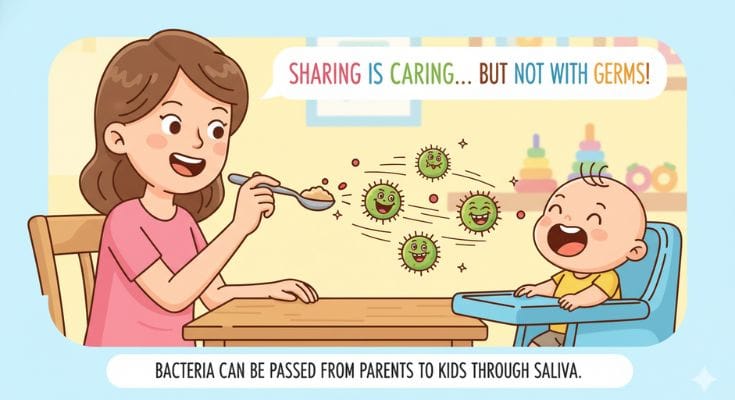
Yep. Sharing spoons, blowing on their food, or those sweet little kisses on the mouth can pass oral bacteria from parent to child. (No shame, most of us have done it without realizing!)
The good news? You can break the cycle.
🦷 Schedule a family cavity risk test and make dental care a team effort, because healthy smiles are learned, not inherited.
7. Should You Wait Until Your Child Complains of Pain to See a Dentist?
Big mistake, and a common one.
Most cavities are sneaky. They don’t cause pain until the damage runs deep, and by that time, it’s often beyond a simple filling and edging dangerously close to root canal territory.
Waiting for pain is like waiting for a car engine light to turn red before checking the oil; by then, the problem’s much bigger (and pricier).
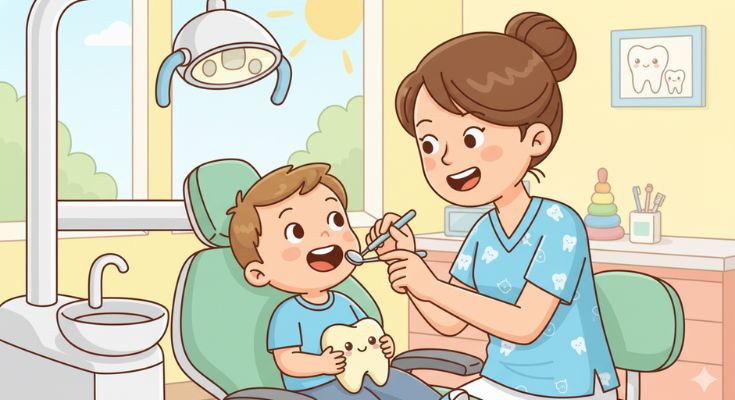
The American Academy of Pediatric Dentistry (AAPD) recommends your child’s first dental visit by age 1, or as soon as their first tooth appears. Those early checkups aren’t just about cleaning, they’re about catching small cavities before they turn into big problems.
Not sure when to book your next visit? Here are the top signs you need a dental checkup, even if your child isn’t complaining yet.
8. Is Getting a Cavity Filled Too Scary or Stressful for Kids?
Once upon a time, maybe.
But today’s pediatric dentists are basically magicians, blending science, comfort, and a little bit of fun to make dental visits a breeze.
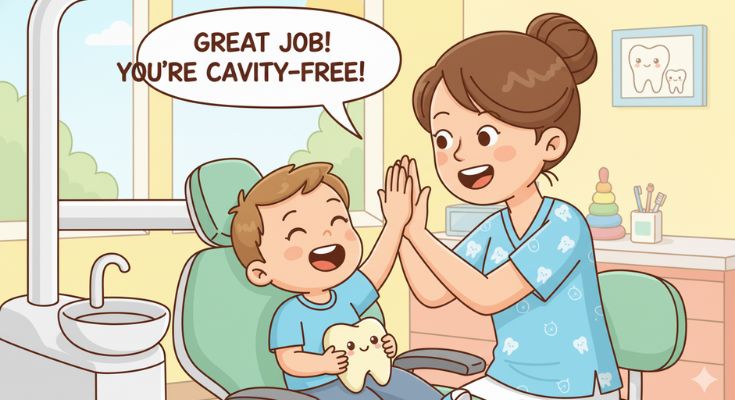
Modern dentistry isn’t scary anymore. Most offices now use:
- Laughing gas (nitrous oxide) to keep kids calm and giggly
- Kid-friendly numbing gels that work fast, no scary needles
- TV ceilings, colorful rooms, and prize boxes that turn checkups into mini adventures
By the end of the visit, many kids walk out grinning and saying, “That was fun!”
Because when dental care feels easy early on, kids grow up seeing dentists as helpers, not something to fear.
Your Cavity-Busting Action Plan
Ready to protect your kid’s smile? Here’s your 3-step cavity defense:
| Step | Action | Tool |
|---|---|---|
| 1 | Brush 2x/day with fluoride | ADA-approved toothpaste |
| 2 | Floss when teeth touch | Kid flossers |
| 3 | Dentist by age 1 | Find a pediatric dentist near you |
Final Thoughts: Don’t Let Cavity Myths Steal Your Kid’s Smile
You’re not a bad parent if you believed one (or a few) of these cavity myths, honestly, most of us did. But now? You’re armed with facts, science, and a real plan to protect your kid’s smile from day one.
So go ahead:
- Schedule that first dentist visit.
- Swap the juice box for water.
- Brush those tiny teeth like your kid’s future orthodontist is watching.
Because a cavity-free smile isn’t just cute, it’s confidence, health, and happiness rolled into one. Your child’s oral health even impacts their body’s overall wellness, learn more about how dental health affects overall health.
FAQs
1. Do cavities in baby teeth really need to be treated?
Yes! Even though baby teeth fall out, untreated cavities can cause pain, infections, and lead to alignment problems when adult teeth come in. Treating them early prevents bigger issues later.
2. Can brushing and flossing cure a cavity?
Unfortunately, no. Once a cavity forms, brushing and flossing can’t repair the enamel; only a dentist can fill or seal it. But a good routine prevents new ones from forming.
3. Are cavities in kids just a normal part of growing up?
Not at all. Cavities are common, but they’re not “normal.” With regular brushing, limited snacking, and early dental visits, most cavities can be completely prevented.
4. Will cavities disappear when baby teeth fall out?
No, the bacteria that caused those cavities stay in your child’s mouth. If untreated, they can attack the new permanent teeth as soon as they appear.
5. Do genetics cause cavities, or can they be prevented?
Genetics play a small role in enamel strength, but habits matter most. Daily brushing, fluoride toothpaste, and dental checkups make a much bigger difference than DNA.

Dr. Alexander Heifitz (Author)
Dr. Alexander Heifitz is the founder of 65 Broadway Dental in NYC, where he combines advanced dental expertise with a patient-first approach. He specializes in cosmetic and restorative treatments such as dental implants, veneers, Invisalign, and smile makeovers, helping New Yorkers achieve both oral health and confidence.
Booking An Appointment
Looking for a reliable dentist in Downtown NYC? Whether you need a routine cleaning, urgent care, or a full smile transformation — we’ve got you covered. We accept most PPO insurance plans and offer flexible scheduling.
+1 (212) 430-3888
Call for appointment
Walk-ins Welcome / Same-Day Appointments Available

Related Blogs

Top Spot for Dental Implants: NYC Financial District
Discover the best place for dental implants in NYC's Financial District. Expert care, advanced tech, and long-lasting smile solutions all in one trusted clinic.
Read More
Dental Whitening NYC: How to Keep Your Teeth White Longer
Keep your smile bright after whitening! Learn top NYC dentist tips to maintain white teeth, avoid stains, and extend your dental whitening results.
Read More